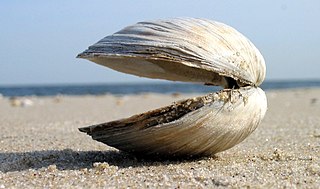
Clam is a common name for several kinds of bivalve mollusc. The word is often applied only to those that are edible and live as infauna, spending most of their lives halfway buried in the sand of the sea floor or riverbeds. Clams have two shells of equal size connected by two adductor muscles and have a powerful burrowing foot. They live in both freshwater and marine environments; in salt water they prefer to burrow down into the mud and the turbidity of the water required varies with species and location; the greatest diversity of these is in North America.

A seashell or sea shell, also known simply as a shell, is a hard, protective outer layer usually created by an animal or organism that lives in the sea. Most seashells are made by mollusks, such as snails, clams, and oysters to protect their soft insides. Empty seashells are often found washed up on beaches by beachcombers. The shells are empty because the animal has died and the soft parts have decomposed or been eaten by another organism.

Bivalvia or bivalves, in previous centuries referred to as the Lamellibranchiata and Pelecypoda, is a class of aquatic molluscs that have laterally compressed soft bodies enclosed by a calcified exoskeleton consisting of a hinged pair of half-shells known as valves. As a group, bivalves have no head and lack some typical molluscan organs such as the radula and the odontophore. Their gills have evolved into ctenidia, specialised organs for feeding and breathing.

A cockle is an edible marine bivalve mollusc. Although many small edible bivalves are loosely called cockles, true cockles are species in the family Cardiidae.

A siphon is an anatomical structure which is part of the body of aquatic molluscs in three classes: Gastropoda, Bivalvia and Cephalopoda.
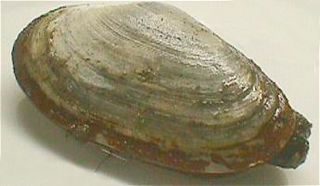
Soft-shell clams or Sand gaper, scientific name Mya arenaria, popularly called "steamers", "softshells", "piss clams", "Ipswich clams", or "Essex clams", are a species of edible saltwater clam, a marine bivalve mollusk in the family Myidae.

The hard clam, also known as the round clam, hard-shellclam, or the quahog, is an edible marine bivalve mollusk that is native to the eastern shores of North America and Central America from Prince Edward Island to the Yucatán Peninsula. It is one of many unrelated edible bivalves that in the United States are frequently referred to simply as clams. Older literature sources may use the systematic name Venus mercenaria; this species is in the family Veneridae, the venus clams.

Buccinum undatum, the common whelk or the waved buccinum, is a large, edible marine gastropod in the family Buccinidae, the "true whelks".
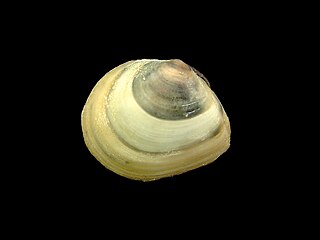
Limecola balthica, commonly called the Baltic macoma, Baltic clam or Baltic tellin, is a small saltwater clam, a marine bivalve mollusk in the family Tellinidae.

Glycymerididae, often misspelled as Glycymeridae, common names dog cockles or bittersweets, is a worldwide family of salt water clams, marine bivalve mollusks in the order Arcida. They are related to the ark clams. This family contains 45 extant species in four genera.
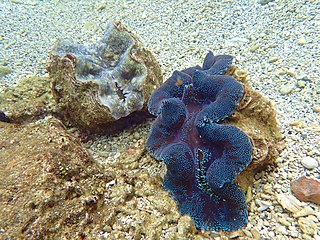
Tridacnidae, common name the giant clams, is a taxonomic subfamily of very large saltwater clams, marine bivalve molluscs in the family Cardiidae, the cockles.

Mya truncata, common name the blunt gaper or truncate softshell, is a species of edible saltwater clam, a marine bivalve mollusk in the family Myidae.
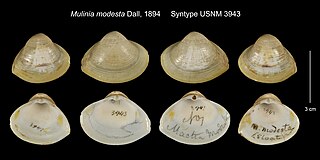
Mulinia modesta is a species of clam belonging to the family Mactridae.

Donax variabilis, known by the common name coquina, is a species of small edible saltwater clam, a marine bivalve mollusc in the family Donacidae, the bean clams. It is a warm water species which occurs in shallow water on sandy beaches on the east coast of the United States and is also plentiful in Mayaro, Trinidad as well as the Caribbean coast of Venezuela. Known as chip-chip in Trinidad and chipi-chipi in Venezuela.

Juliidae, common name the bivalved gastropods, is a family of small sea snails, marine gastropod mollusks or micromollusks in the superfamily Oxynooidea, an opisthobranch group.

Lamelliconcha circinata, common name the "purple venus clam", is a species of bivalve mollusc in the family Veneridae, the venus clams. This species can be found around the coasts of the islands in the West Indies.

Gastrochaena is a genus of saltwater clams, marine bivalve molluscs in the family Gastrochaenidae. The type species of this genus is Gastrochaena cuneiformis.
Potamocorbula amurensis is a species of small saltwater clam, a marine bivalve mollusc in the order Myida. Common names include the overbite clam, the Asian clam, the Amur River clam and the brackish-water corbula. The species is native to marine and brackish waters in the northern Pacific Ocean, its range extending from Siberia to China, Korea and Japan. It has become naturalised in San Francisco Bay.

Solemya is a genus of saltwater clams, marine bivalve mollusks in the family Solemyidae, the awning clams. Solemya is the type genus of the family Solemyidae.
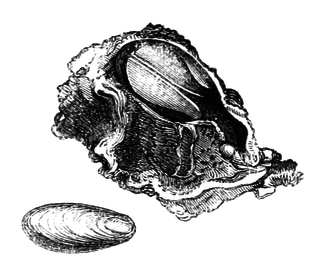
Rocellaria is a genus of saltwater clams, marine bivalve molluscs in the family Gastrochaenidae.


















